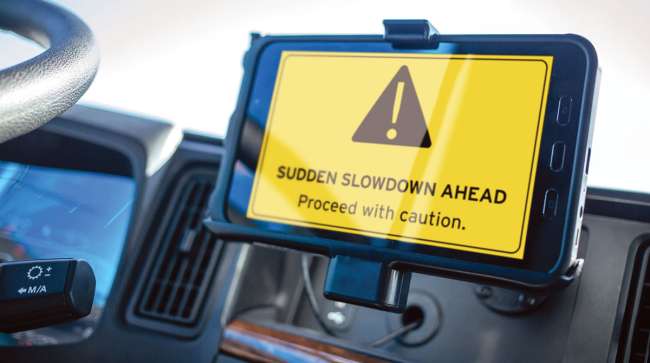Staff Reporter
N.J. DOT Latest to Offer Truckers Real-Time Traffic Alerts

[Stay on top of transportation news: Get TTNews in your inbox.]
New Jersey has launched a traffic-alert system using Drivewyze to warn commercial truckers about potential safety issues along 600 miles of state highways.
The state entered a joint partnership between Intelligent Imaging Systems (IIS) through its subsidiary Drivewyze Inc. and transportation and data analytics firm INRIX.
New Jersey now joins North Carolina in adopting the new traffic-alert system.
#NJDOTNews: We’ve partnered w/@Drivewyze and @INRIX to develop a real-time traffic alert system for commercial vehicle drivers. This program is designed to help reduce commercial vehicle crashes on NJ state highways. Click here for more https://t.co/6WJ2s8tBsR#VisionZero pic.twitter.com/o1Bwky6JEa — NJDOT (@NewJerseyDOT) January 11, 2022
“The ability to alert commercial vehicle drivers to unexpected traffic conditions will improve safety for everyone driving on New Jersey’s highways,” said Diane Gutierrez-Scaccetti, commissioner of the New Jersey Department of Transportation. “By warning drivers of congestion that is miles ahead, drivers of large commercial vehicles will have the extra time needed to safely slow down.”
NJDOT said a fully loaded tractor-trailer needs a longer stopping distance — taking 66% longer to stop (at 65 mph) — than a passenger car. It added that many interstate collisions involve secondary crashes in which a truck or car rear-ends a stopped vehicle in a queue from an initial crash.
Using Drivewyze software in an app or in-cabin alert system, commercial truck drivers will receive alerts from two to three miles before a slowdown to better prepare them to stop — helping prevent secondary crashes.
Notifications will be sent to subscribed drivers as they travel within the geographical boundaries of New Jersey, including highways, the Atlantic City Expressway, Garden State Parkway and New Jersey Turnpike. Alerts include:
- Slow down ahead when coming upon dangerous curves.
- Caution when nearing a low bridge.
- Warnings for mountain corridor steep grades and runaway ramps.
“The New Jersey Motor Truck Association applauds the efforts to provide advance safety alerts to commercial truck drivers via Drivewyze,” said executive director Gail Toth. “These efforts will help to keep our workplace — the highways — safer for all.”
New Jersey and North Carolina DOTs used their membership in the Eastern Transportation Coalition and participation in its Traffic Data Marketplace to help obtain the Drivewyze safety-alert systems, according to IIS.
Andrew Barksdale, public relations officer with NCDOT, said the pilot project cost $250,000 and was paid for with state transportation funds.
Want more news? Listen to today's daily briefing above or go here for more info
Barksdale said the alert system has worked well. More than 42,000 congestion and sudden slowdown alerts have been sent to Drivewyze users in North Carolina since September. Truckers also have received alerts to help navigate through a work zone in western North Carolina. NCDOT soon will study the project’s safety benefits, Barksdale added.
Doug Siefkes, a Drivewyze spokesman, said that during the last three months, IIS performed a beta test with its Drivewyze safety notification subscribers who received the alerts. It found in New Jersey there were 104,000 alerts and 14,000 incidents while North Carolina had 38,000 alerts and 7,000 incidents.
“Incidents in this case are either based on congestion (sustained traffic on a road segment for at least three minutes) or sudden slowdowns (temporary queue backups),” Siefkes said. “The queue backups could be for any reason: accidents, lane closures in work zones, weather conditions.”
Mark Burfeind, INRIX director of global communications, said the new alert systems in New Jersey and North Carolina are keeping freeways and interstates safer.
Pennsylvania DOT-Case Study by Transport Topics
Burfeind pointed to a crash-detection study conducted by the Pennsylvania Department of Transportation using INRIX real-time traffic data and Waze app crowdsourced data via connected users of the navigation system.
PennDOT revealed an early key finding from the study, published in April, was that crowdsourced data from the Waze navigation system and INRIX outperformed traditional Traffic Management Center personnel — detecting 86.7% of reportable crashes on PennDOT’s core roadway network.
The study found that secondary and work-zone crashes in existing traffic congestion caused more injuries to motorists than other crashes.
“The location of these crashes was of particular interest, with 32% of work-zone crashes and 49% of secondary crashes occurring more than 2 miles back from the origin point of congestion,” the report noted, adding that 46% of secondary crashes happened more than one hour after a primary crash.

